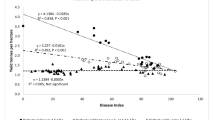Abstract
A meta-analysis of severity and yield loss from ascochyta blight (AB) on field pea was performed using 18 field experiments conducted over eight seasons in 13 locations in Western Australia (WA). The severity of AB, across the WA grain-belt, reached its maximum limit (AB severity 5) during mid-April sowing and linearly declined to almost nil by mid-July sowing. Pre-sowing rainfall had a significant effect on AB severity: the more rainfall events that occurred the less was the disease severity. The regional and seasonal difference in the rate of decline of the AB severity (slope of the regression line) with delay in sowing was not significant, whereas the intercepts were largely significant indicating there were differences in the initial AB severity status between the regions and seasons. Fungicide control [Impact® in-furrow (flutriafol) application or fortnightly sprays of Bravo® (chlorothalonil)] did not reduce the disease severity in early sowing (week ending 7 May). The yield loss due to AB was calculated as 10.3% per AB severity unit, indicating that a loss of ≥50% could occur with the highest severity. Magnet showed significantly higher yield loss compared to all other varieties. The differences in yield loss between the five regions were not significant. On the other hand, a dry finishing season resulted in significantly higher yield loss than a wet finishing season. These analyses will help design improved strategies for AB management in field pea in Western Australia.






Similar content being viewed by others
References
Bretag TW (1985) Chemical control of ascochyta blight of field peas. Australas Plant Pathol 14:42–43
Bretag TW (1991) Epidemiology and control of ascochyta blight of field peas. PhD Thesis, La Trobe University, Australia
Bretag TW, Keane PJ, Price TV (1995) Effect of ascochyta blight on grain yield of field peas (Pisum sativum L.) grown in southern Australia. Aust J Exp Agric 35:531–536
Bretag TW, Keane PJ, Price TV (2000) Effect of sowing date on the severity of ascochyta blight in field peas (Pisum sativum L.) grown in Wimmera region of Victoria. Aust J Exp Agric 40:1113–1119
Bretag TW, Keane PJ, Price TV (2006) The epidemiology and control of ascochyta blight in field peas: a review. Aust J Agric Res 57:883–902
Davidson JA, Kimber RBE (2007) Integrated disease management of ascochyta blight in pulse crops. Eur J Plant Pathol 119:99–110
Davidson JA, Ramsey MD (2000) Pea yield decline syndrome in South Australia: the role of disease and the impact of agronomic practice. Aust J Agric Res 51:347–354
Davidson JA, Hartley D, Priest M, Herdina, Krysinska-Kaczmarek K, McKay A, Scott ES (2009) A new species of Phoma causes ascochyta blight symptoms of field peas (Pisum sativum) in South Australia. Mycologica 101:120–128
Glass GV (1976) Primary, secondary, and meta-analysis of research. Educ Res 5:3–8
Heenan DP (1994) Effects of sowing time on growth and grain yield of lupin and field pea in south–eastern New South Wales. Aust J Exp Agric 34:1137–1142
McDonald GK, Peck D (2009) Effects of crop rotation, residue retention and sowing time on the incidence and survival of ascochyta blight and its effect on grain yield of field peas (Pisum sativum L.). Field Crops Res 111:11–21
McMurray LS, Davidson JA, Lines MD, Leonforte AL, Salam MU (2011) Combining management and breeding advances to improve field pea (Pisum sativum) grain yields under changing climatic conditions in south–eastern Australia. Euphytica doi:10.1007/s10681-011-0362-9
Peever TL, Barve MT, Stone LJ, Kaiser WJ (2007) Evolutionary relationships among Ascochyta species infecting wild and cultivated hosts in legume tribes Cicereae and Vicieae. Mycologia 99:59–77
Rosenberg MS, Garrett KA, Su Z, Bowden RL (2004) Meta-analysis in plant pathology: synthesizing research results. Phytopathology 94:1013–1017
Salam MU, Galloway J (2005) “Blackspot Manager” for understanding blackspot of peas and ascochyta blight management. In: ‘Lupins and Pulses Updates, Agribusiness Crop Updates 2005’. pp. 67–69 (Department of Agriculture, Western Australia: South Perth, WA).
Salam MU, Galloway J, Diggle AJ, MacLeod WJ (2003a) Blackspot spores mature earlier in the southern regions. In: ‘Pulse Research and Industry Development in Western Australia, Agribusiness Crop Updates 2003’. pp. 63–64 (Department of Agriculture, Western Australia: South Perth, WA).
Salam MU, Khangura RK, Diggle AJ, Barbetti MJ (2003b) Blackleg Sporacle: A model for predicting onset of pseudothecia maturity and seasonal ascospore showers in relation to blackleg of canola. Phytopathology 93:1073–1081
Salam MU, Fitt BDL, Aubertot JN, Diggle AJ, Huang YJ, Barbetti MJ, Gladders P, Jedryczka M, Khangura RK, Wratten N, Fernando WGD, Penaud A, Pinochet X, Sivasithamparam K (2007) Two weather-based models for predicting onset of seasonal release of ascospores of Leptosphaeria maculans or L. biglobosa, causes of phoma stem canker of oilseed rape. Plant Pathol 56:412–423
Salam MU, Galloway J, MacLeod WJ, Davidson JA, Seymour M, Prichard I, Salam KP, Diggle AJ, Maling T (2011) G1 Blackspot Manager model predicts the maturity and release of ascospores in relation to ascochyta blight on field pea. Australas Plant Pathol doi:10.1007/s13313-011-0035-0
Schoeny A, Jumel S, Rouault F, Le May C, Tivoli B (2007) Assessment of airborne primary inoculum availability and modelling of disease onset of ascochyta blight in field peas. Eur J Plant Pathol 119:87–97
Acknowledgements
We thank the Australian Grains Research and Development Corporation (GRDC) for financial assistance in this work. The last author acknowledges DAFWA for financial support of his salary and research. Authors are highly grateful to one of the anonymous reviewers who patiently went through the manuscript and passed useful comments for its improvement.
Author information
Authors and Affiliations
Corresponding author
Rights and permissions
About this article
Cite this article
Salam, M.U., MacLeod, W.J., Maling, T. et al. A meta-analysis of severity and yield loss from ascochyta blight on field pea in Western Australia. Australasian Plant Pathol. 40, 591–600 (2011). https://doi.org/10.1007/s13313-011-0034-1
Received:
Accepted:
Published:
Issue Date:
DOI: https://doi.org/10.1007/s13313-011-0034-1




